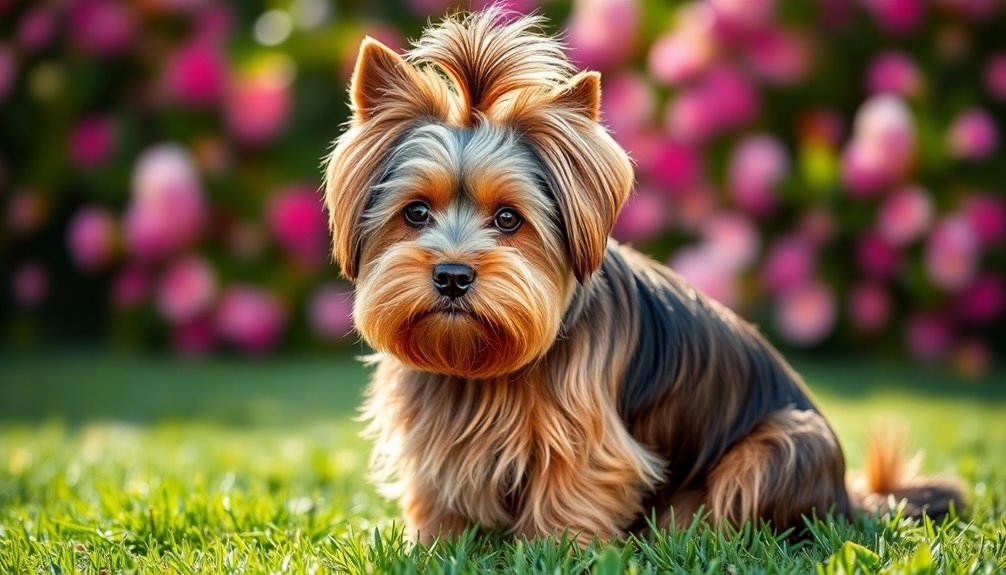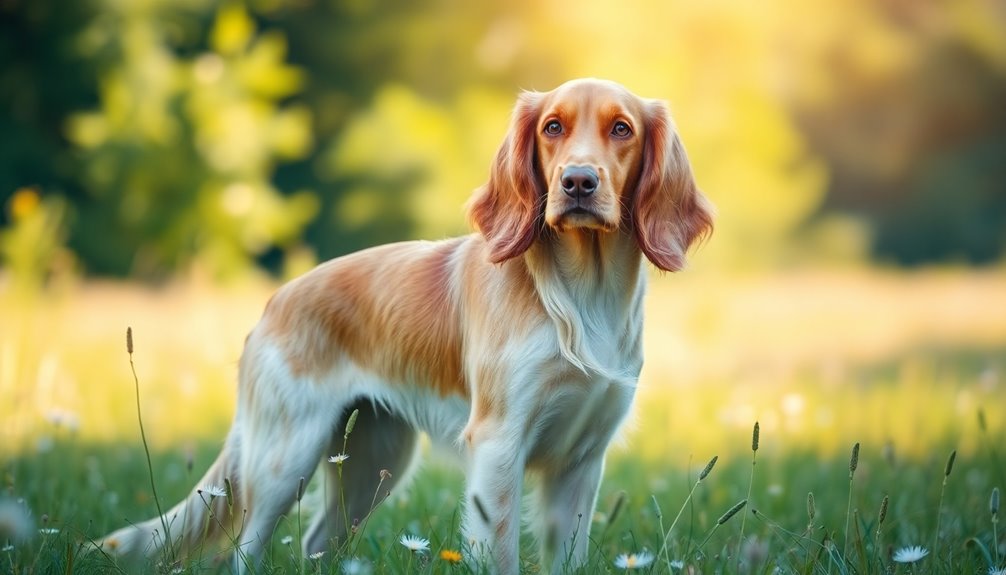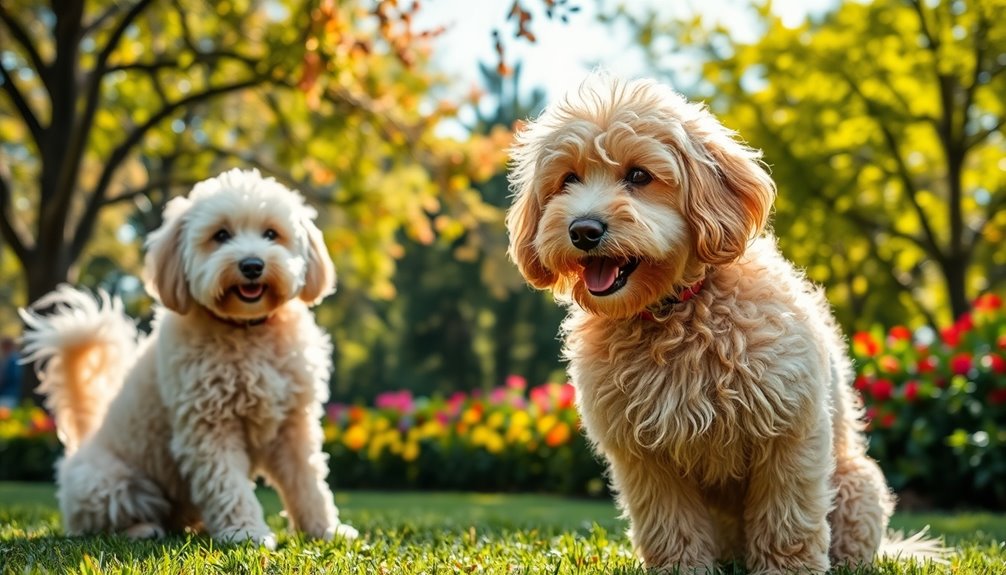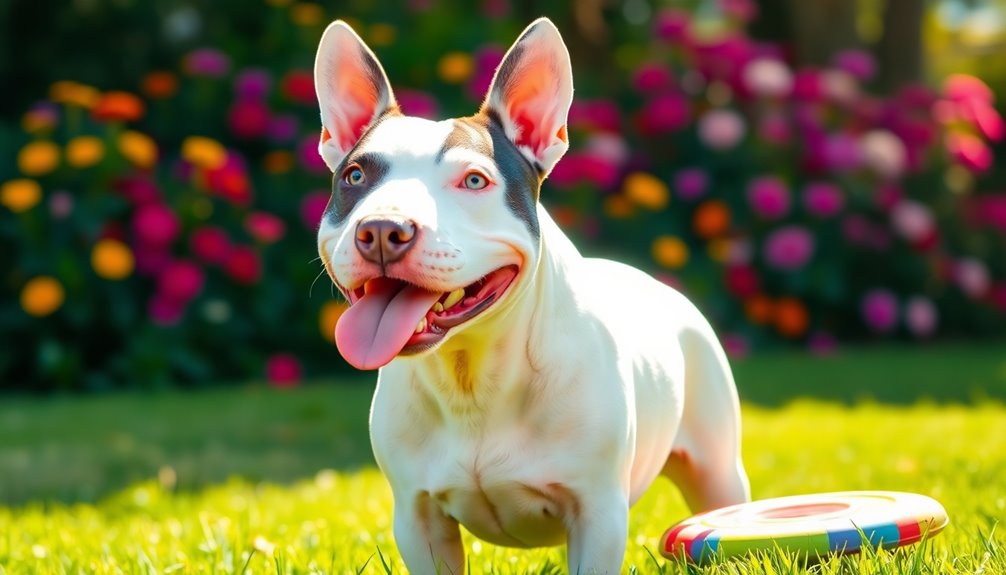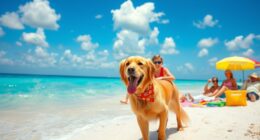The Dandie Dinmont Terrier is truly a uniquely styled breed, with its long body, short legs, and distinctive curly topknot. You'll notice its charming personality shines through with a friendly and affectionate demeanor. This small terrier typically stands 8-11 inches tall and weighs between 18-24 pounds. Originating from the Cheviot Hills, these dogs were originally bred for hunting vermin. They thrive in family settings, loving strong bonds with their humans, especially older kids. To keep their coat healthy, daily brushing is essential. If you're intrigued by this rare breed, there's plenty more to explore about their care and traits!
Key Takeaways
- The Dandie Dinmont Terrier is a small breed known for its distinctive long body, short legs, and unique curly topknot.
- They come in two color varieties: pepper (dark bluish-black to silvery gray) and mustard (reddish brown to fawn).
- This breed has a friendly and affectionate temperament, making them excellent companions for families and individuals alike.
- Originally developed for hunting badgers, they maintain a strong prey drive and require careful supervision when off-leash.
- Regular grooming, including hand-stripping and daily brushing, is essential to keep their coat healthy and prevent matting.
Introduction
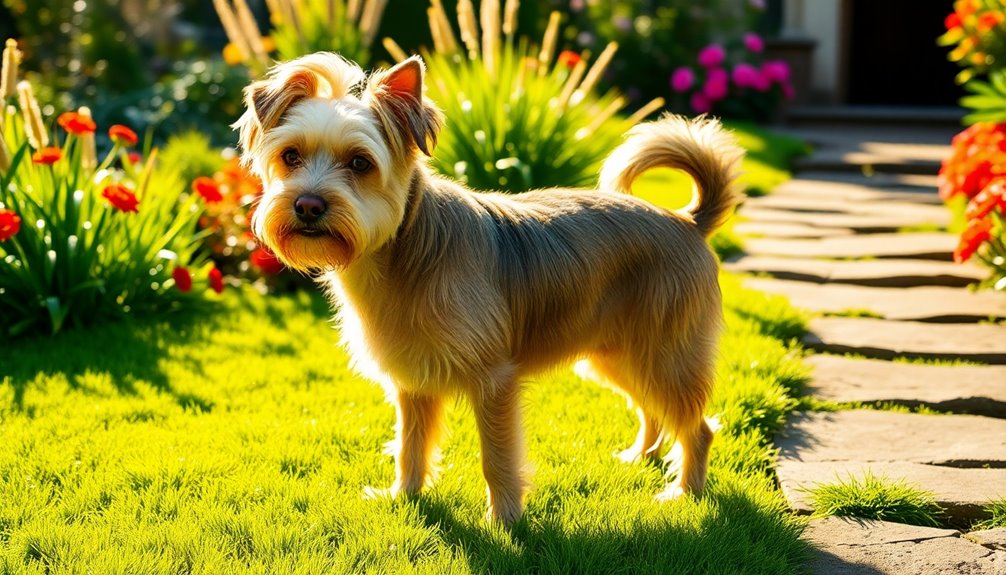
If you're looking for a unique and charming dog breed, the Dandie Dinmont Terrier might just be the perfect fit for you. This small breed stands only 8-11 inches tall and weighs between 18-24 pounds, making them an ideal companion for various living situations, including apartments.
With their long bodies and short legs, they possess a distinct look, enhanced by their medium-length coat, which comes in pepper or mustard colors. Their broad, low-set, floppy ears and long, shaggy tail add to their delightful appearance.
The Dandie Dinmont Terrier is known for its friendly and playful personality. While they bond closely with one person, they adapt well to family life and get along with children. However, their stubborn streak means you'll need to employ assertive and patient training methods. This breed has an average energy level and requires 20-40 minutes of exercise daily to stay healthy and happy.
With moderate grooming needs, daily brushing and occasional coat maintenance will keep them looking their best. They require 20-40 minutes of exercise daily, which helps maintain their lean appearance.
This breed enjoys companionship and doesn't like being left alone, thriving in a loving family environment. If you want a loyal, alert, yet calm companion, the Dandie Dinmont Terrier is worth considering.
History and Origin
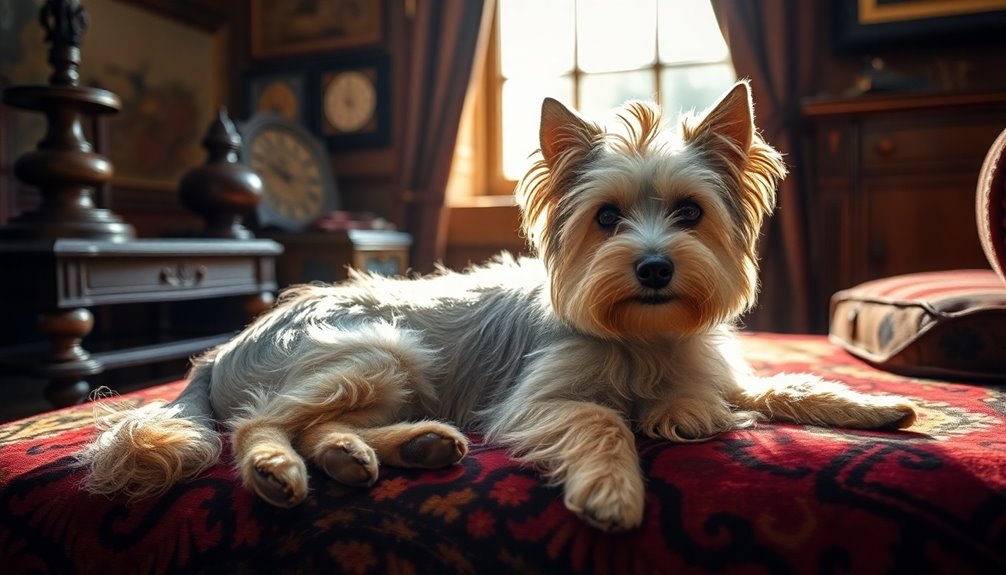
The Dandie Dinmont Terrier originated in the borderland between England and Scotland, specifically in the Cheviot Hills area.
This breed was primarily developed for hunting badgers and controlling vermin, showcasing its utility for local farmers and Romani families. The breed's name is derived from a character in Sir Walter Scott's novel "Guy Mannering," making it the only breed named after a fictional character. Understanding its roots helps you appreciate the breed's unique character and purpose.
Where and when the breed originated
Originating in the rugged border regions between Scotland and England, the Dandie Dinmont Terrier has a rich history that dates back to around 1700. Specifically, this breed hails from the Cheviot Hills and the Anglo-Scottish border country, where hunting and pest control were essential.
The earliest accounts of the Dandie Dinmont Terrier emerge in the 1600s, but it wasn't until the 1700s that it gained recognition as a distinct breed. This breed is recognized as one of the rarest native breeds in the British Isles since 2006, highlighting its unique status and need for preservation.
The breed's name comes from Sir Walter Scott's character in his 1814 novel "Guy Mannering," which helped popularize it. This charming terrier is also linked to the Allans of Holystone in Northumberland and key figures like James Davidson, a farmer who contributed to the breed's development.
Romani families played a vital role in keeping the breed pure, while notable figures such as Queen Victoria further elevated its status.
The Dandie Dinmont Terrier Club, established in 1875, marked the beginning of organized efforts to promote the breed, which earned recognition from the American Kennel Club in 1886 and the United Kennel Club in 1918.
Badger Hunting and Vermin Control
As the Dandie Dinmont Terrier gained recognition in the 1700s, its role in badger hunting and vermin control became increasingly significant. Bred in the 1600s, these dogs were initially developed to hunt otters and control pests like rats and mice. Their unique physical traits—a long body, short legs, and a tough coat—made them well-suited for navigating rugged terrain and tight burrows where badgers and otters lived.
You'd admire their tracking abilities; with a keen sense of smell and unyielding tenacity, Dandie Dinmont Terriers excelled in locating prey underground. They played a crucial role in managing badger populations, which were often regarded as pests that threatened agricultural interests. By utilizing various hunting methods like tracking and digging, they not only protected livestock but also contributed to the local economy through fur trading. This relationship highlights how wildlife diversity and traditional hunting practices were essential for indigenous cultures and their survival.
Even today, their hunting instincts shine in activities like barn hunts, where they mimic historical hunting scenarios.
The Dandie Dinmont Terrier remains an energetic, playful companion, requiring regular exercise and mental stimulation to stay happy and healthy, all while retaining the traits that made them exceptional hunters.
Physical Characteristics
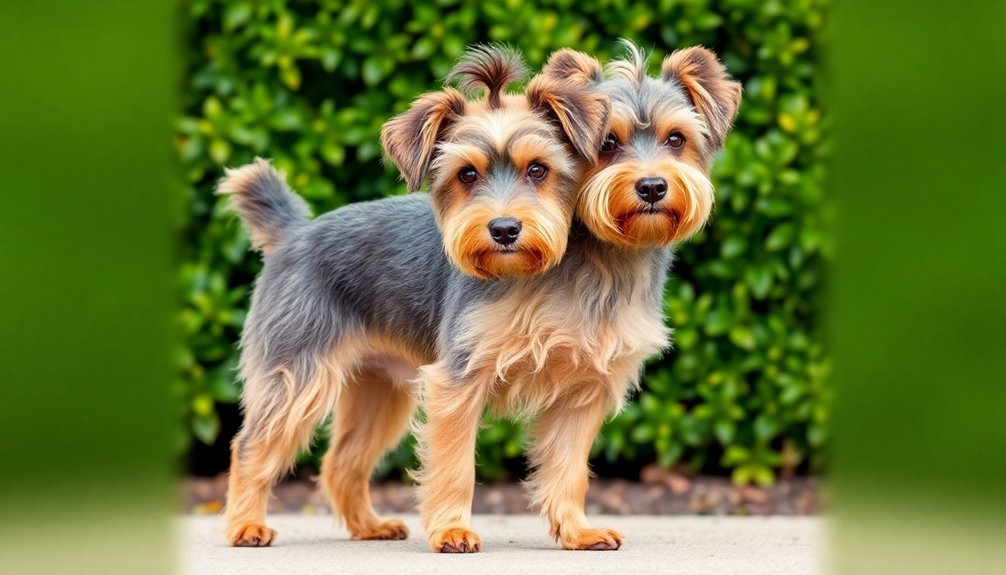
When you look at a Dandie Dinmont Terrier, you'll notice its compact size, typically standing between 8 and 11 inches tall and weighing around 18 to 24 pounds. Its coat features a unique combination of hard and soft hair, with a distinctive curly topknot and beard that give it a charming appearance. These physical traits not only define the breed's character but also contribute to its overall appeal. The Dandie Dinmont Terrier is recognized as a distinct Scottish terrier breed, highlighting its unique heritage and role in hunting.
Size, weight, and coat details
The Dandie Dinmont Terrier boasts a distinctive appearance that sets it apart in the canine world. Standing between 8 to 11 inches tall at the withers and measuring 16 to 21 inches in body length, these dogs have a long and low body shape, with a back line that's higher in the rear.
Compared to Scottish terriers, they're similar in size but larger than tiny breeds like Chihuahuas and Yorkies. Weighing between 18 to 24 pounds, both male and female Dandie Dinmonts maintain a lean and athletic build, which means they require regular exercise to stay healthy. Their size makes them suitable for lap companionship, making them a delightful choice for those who enjoy close canine company.
Their coat is medium in length, featuring a unique combination of hard and soft hairs. The body coat feels crisp to the touch, while the head sport soft, silky hair. Their ears are adorned with a thin feather of light hair near the tips. You'll find Dandie Dinmonts in two main color varieties: pepper, which ranges from a dark bluish-black to a light silvery gray, and mustard, from reddish brown to fawn.
Grooming involves daily brushing and occasional stripping or clipping, but they shed very little.
Curly Topknot and Beard
Apart from their distinctive size and coat, Dandie Dinmont Terriers are easily recognized by their unique curly topknot and well-groomed facial hair. The topknot, made of soft and silky hair, forms a distinctive puff on the top of their heads, adding to their charming appearance. To keep this feature looking its best, you'll need to brush it daily, especially when your pup is young. Regular grooming prevents matting, ensuring the hair stays smooth and free of knots.
The breed's well-defined facial structure is beautifully framed by the topknot and additional facial hair. While there's no specific mention of a beard, the facial hair requires your attention to stay clean and tangle-free. This grooming routine is essential as it complements the Dandie Dinmont's large, intelligent eyes and pendulous ears. Additionally, their weatherproof coat helps protect them during outdoor activities, making grooming even more important for maintaining their appearance.
The strong jaw and scissor bite further enhance the overall head structure, while a muscular neck supports these features. Together, the topknot and facial hair contribute to the breed's unique, gentlemanly appearance that stands out in any setting.
With proper care, your Dandie Dinmont will always look sharp and stylish!
Temperament and Personality
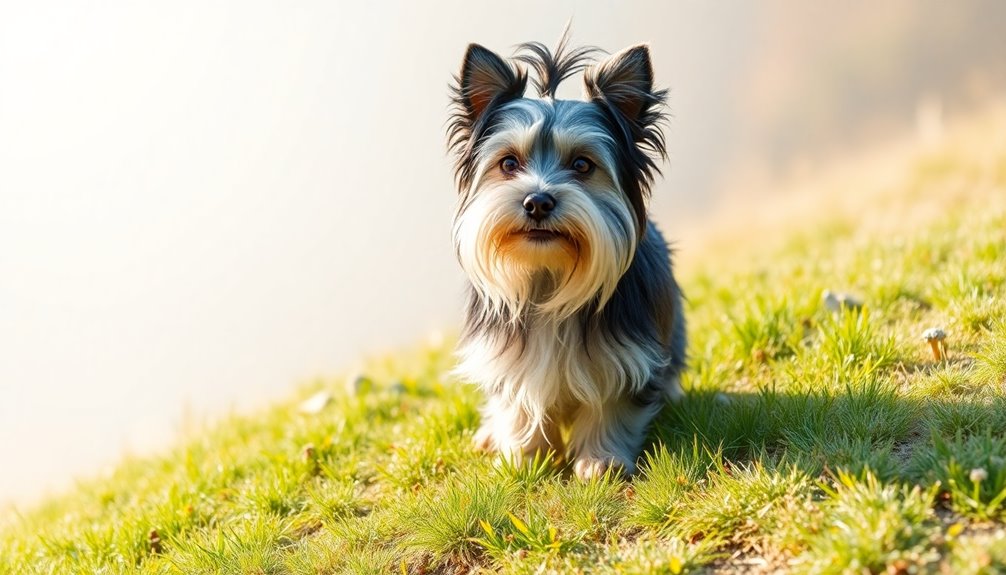
When you think of a Dandie Dinmont Terrier, picture a playful and spirited companion that thrives in family settings. These dogs adapt well to various lifestyles, making them great for individuals, families, or even as a buddy for other pets. Their affectionate nature and loyalty ensure they'll fit right into your life. With a lifespan of 12–15 years, they can be a long-term addition to your family, bringing joy and companionship for many years to come.
Playful and Spirited Demeanor
Dandie Dinmont Terriers are known for their playful and spirited demeanor, making them delightful companions for families and individuals alike. Their affectionate nature means they form strong bonds with their families, showering you with loyalty and love.
While they're dignified and somewhat reserved around strangers, they're always eager to engage with those they trust.
These intelligent pups thrive on positive reinforcement training, quickly learning new tricks and activities, especially when tasty treats are involved. Their moderate energy level means they enjoy short daily walks or playtime in a fenced yard, but they're just as happy lounging around between activities. Early obedience training is recommended to prevent excessive barking and territorial behavior, especially towards larger dogs of the same sex.
This adaptability makes them suitable for various living situations, including apartments.
Dandie Dinmonts also possess a watchful side, alerting you to unexpected noises. Although they're generally soft-spoken, they can be territorial, especially with larger dogs of the same sex, which might lead to some barking if not managed properly.
With regular mental stimulation and a bit of consistency in training, you'll find that their playful spirit shines through, bringing joy and vitality to your home.
Suitability for families, individuals, or other pets
While Dandie Dinmont Terriers are known for their playful nature, their suitability for families, individuals, and other pets largely hinges on their affectionate temperament and adaptability.
These dogs form strong bonds with family members and are particularly loyal and loving, especially towards older children. They thrive in various living situations, whether you have a yard or not, as long as you can provide daily walks and moderate exercise. Additionally, they are considered hypoallergenic; this quality can be beneficial for families with allergy sufferers. Creating a calm environment can further enhance their adaptability and comfort within the home.
However, they do need respect for their boundaries, particularly from younger kids, and supervision is essential to ensure they're handled gently. Dandies may also benefit from having a companion, as they don't like being left alone for long periods.
For individuals, their independent yet strong-willed nature requires patient training and consistent socialization. They adapt well to urban or rural settings, but they still need daily exercise and mental stimulation.
When it comes to other pets, they can be territorial, particularly with larger dogs of the same sex, so early socialization is crucial.
Health and Lifespan

When it comes to the health and lifespan of your Dandie Dinmont Terrier, you can expect an average life of 12 to 15 years with proper care. This breed is generally healthy, but they're prone to certain health issues, so staying vigilant is key. Regular vet check-ups are essential for maintaining optimal health and addressing any concerns early on.
Typical lifespan of the breed
For those considering adding a Dandie Dinmont Terrier to their family, it's important to know they typically live between 12 to 15 years. Some studies even suggest an average life expectancy of around 12.8 years. With proper care, your Dandie can thrive and may even reach up to 14 years. This lifespan is comparable to that of other purebred and crossbred dogs.
Several factors influence your dog's longevity. Proper care and nutrition greatly impact their lifespan, so make sure to provide a balanced diet and regular veterinary check-ups. Consistent health monitoring and preventive care, along with appropriate exercise routines and mental stimulation, are essential for keeping your Dandie healthy. Additionally, regular health checks can help monitor changes in your dog's health as they age.
As your Dandie enters their senior years, usually around 10 to 12 years, you may notice changes in energy levels and exercise tolerance. Modifying their diet and incorporating cognitive enrichment activities will help maintain their quality of life.
Common health concerns or genetic predispositions
Addressing common health concerns and genetic predispositions is crucial for Dandie Dinmont Terrier owners. This breed is prone to several eye issues, including glaucoma, progressive retinal atrophy (PRA), cataracts, and corneal dystrophy, which can lead to blindness. Watch for symptoms like dilated pupils, cloudy lenses, or any changes in vision. Additionally, conditions like distichiasis can cause chronic eye pain due to extra hairs irritating the eye surface.
Musculoskeletal problems are also common, with intervertebral disc disease, hip and elbow dysplasia, and arthritis affecting mobility. Regular exercise is important for managing overall health and mitigating some of these issues. Keep an eye out for signs of lameness, especially as your dog matures.
Systemic health concerns include Cushing's syndrome, which results in excessive cortisol production, and lymphoma, a cancer affecting the immune system. Many of these health issues have genetic components, highlighting the importance of regular veterinary check-ups and genetic testing.
Tips for maintaining health and wellness
Maintaining the health and wellness of your Dandie Dinmont Terrier involves a balanced approach that includes proper diet, regular exercise, grooming, and routine veterinary care.
Start by feeding high-quality dog food with real meat as the first ingredient, avoiding fillers like corn and soy. Incorporate fresh fruits and veggies for essential nutrients, and limit treats to no more than 10% of their daily calories to prevent weight gain.
Next, ensure your pup gets moderate exercise with daily walks lasting 30–60 minutes, along with play sessions or activities like fetch to keep them engaged. Moderate energy levels necessitate regular exercise, making it important to tailor activities to their needs.
Be careful with intense activities that might stress their back, and always provide mental stimulation through interactive games.
Grooming is crucial, so brush your Dandie at least twice a week and schedule intensive grooming every few months.
Regularly check their ears and trim nails to maintain hygiene.
Finally, don't skip routine vet check-ups to catch any health issues early.
Monitor your dog's behavior and appearance for changes, and consider pet health insurance to help with medical costs.
Regular dental care is also essential to prevent oral diseases.
Care Requirements
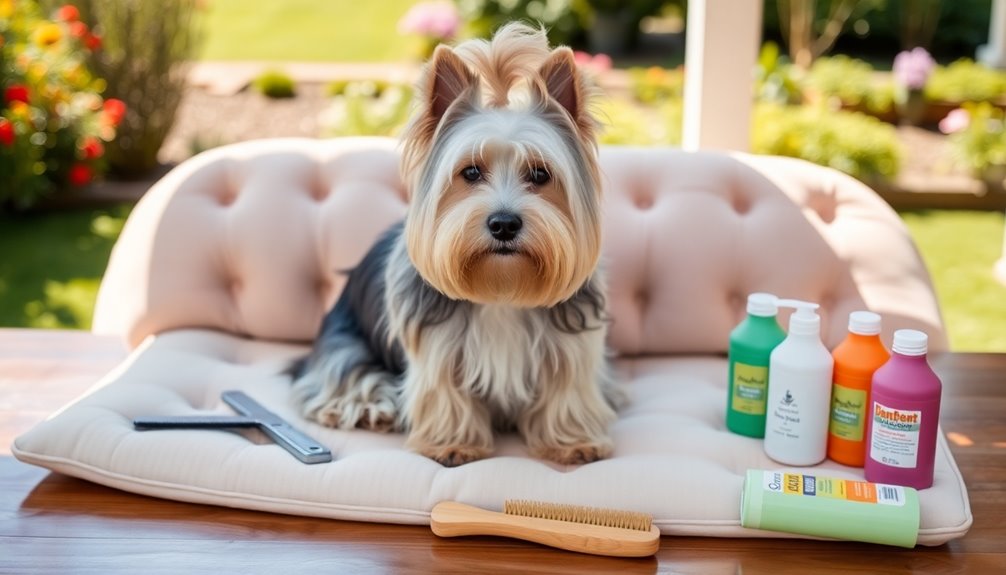
Caring for a Dandie Dinmont Terrier involves regular hand-stripping to maintain their unique coat and ensure it stays healthy. You'll need to provide moderate exercise, like daily walks or playtime, to keep their energy levels in check. Additionally, focus on a consistent, high-quality diet to support their overall well-being. It's important to note that they have specific health issues to be aware of, such as Intervertebral Disc Disease and glaucoma.
Regular Hand-Stripping Required
Regular hand-stripping is essential for keeping your Dandie Dinmont Terrier's coat in top condition. This technique involves removing dead hairs by the root, allowing new coat growth.
Start by using your thumb and forefinger to grasp a few strands and pull them out, beginning behind the ears and working down the body, over the legs and feet. A fine red stripping knife, which should be made blunt before use, is crucial for this process. To improve your grip, consider wearing disposable rubber gloves or a rubber fingerstall.
For a traditional look, aim to hand-strip your Dandie every few months—quarterly or every other month is ideal. If you prefer a scruffier appearance, you can do this at the change of each season. Puppies can be hand-stripped for the first time around four months old, indicated by black tips in their coat. Daily brushing is also key to maintaining your Dandie's coat and preventing matting.
In addition to hand-stripping, daily brushing helps remove dirt and prevents matting, which can lead to skin infections.
Regular grooming sessions also allow you to check for any health concerns like sores or ticks, ensuring your Dandie remains healthy and happy.
Exercise requirements and energy levels
For a happy and healthy Dandie Dinmont Terrier, daily exercise is crucial. Aim for at least 30 minutes to 1 hour of physical activity each day to keep your pup fit and content. Daily walks are an excellent way to meet this need, but don't forget about interactive play sessions. Games like fetch in a fenced yard or engaging in low-impact canine sports such as agility or obedience can also be beneficial.
You should tailor exercise to your dog's age and energy level. For young puppies, stick to short, controlled play sessions to avoid overexertion and protect their developing bones and joints. High-impact activities should wait until they're fully mature, typically around 12-18 months. Additionally, due to their strong prey drive, it's important to provide a secure environment during playtime.
Mental stimulation is equally important. Incorporate puzzle toys and training sessions that engage your dog's mind while providing physical activity. Short, focused training can help maintain their attention and prevent boredom, which can lead to behavioral issues.
Always supervise exercise to ensure your Dandie Dinmont doesn't overdo it or strain their back. Leash walking and a secure yard are essential due to their strong chase instinct.
Consult your vet for tailored exercise recommendations based on your dog's individual needs.
Feeding tips and diet recommendations
Maintaining a balanced diet is just as important as meeting your Dandie Dinmont Terrier's exercise needs. Focus on high-quality protein sources like beef, chicken, turkey, lamb, and fish to keep your pup healthy and energetic. Raw food promotes health and happiness in Dandie Dinmont Terriers, making it a beneficial option to consider.
Healthy fats are crucial too, so include a mix of saturated and unsaturated fats in their meals. Small amounts of carbohydrates from vegetables and fruits provide essential fiber, prebiotics, and antioxidants.
For puppies, feed a high-quality puppy diet 3-4 times a day until they're six months old, then transition to twice daily. Adult Dandies should also be fed twice daily, adjusting portions based on weight and activity.
Make the switch to adult dog food designed for small breeds around 12 months. Watch out for obesity, a significant risk for this breed. Avoid giving them human food and treats, as these can lead to weight gain.
If you're considering a raw diet, ensure it includes the right nutrient ratios. Alternatively, high-quality commercial foods with meat as the primary ingredient can work well.
Regularly monitor your dog's diet and health to prevent any breed-related issues.
Training and Socialization

Training your Dandie Dinmont Terrier requires a moderately independent approach, as they think for themselves and can be a bit stubborn. To ensure a smooth socialization process, gradually introduce them to new friends and experiences, helping them adjust without feeling overwhelmed. Socialization process begins with responsible breeders before bringing a puppy home, which can also aid in their adaptability. You may encounter some challenges with housebreaking, but with patience and consistency, you can guide them toward success.
Moderately Independent Training Style
With their moderately independent nature, Dandie Dinmont Terriers require a unique approach to training and socialization. Start with basic obedience commands like sit, stay, and come. Use positive reinforcement—treats, praise, and affection—to reward their good behavior.
Keep training sessions short to hold their attention, and be consistent with commands to avoid confusion. Always end on a positive note to keep them eager for the next session. Consistency and patience are crucial for effective training, as these dogs can be stubborn. A firm yet gentle approach works best, so avoid scolding for mistakes; it can hinder progress. If you encounter challenges, consider seeking help from a professional dog trainer.
Socialization is just as crucial to prevent potential issues with aggression or fear. Introduce your Dandie Dinmont to new people and animals in controlled settings.
Regular walks expose them to different environments, promoting confidence and good behavior. Starting socialization early helps ensure your dog grows into a well-adjusted adult.
Gradual Introductions to New Friends
To foster a well-adjusted Dandie Dinmont Terrier, gradual introductions to new friends are essential. Early socialization plays a crucial role in developing a sociable and confident companion. Start exposing your puppy to diverse people, places, and experiences as soon as you bring them home. This will help mitigate potential behavioral issues and foster adaptability.
When introducing your Dandie Dinmont to strangers, remember they can be reserved and cautious. Consistent exposure to various individuals, combined with positive reinforcement during interactions, will help your dog become more comfortable and affable. Additionally, since Dandie Dinmont Terriers have a distinctive coat, regular grooming should also be part of your routine to keep them looking their best.
Additionally, your terrier's prey drive means you must manage interactions with smaller animals carefully. While they usually get along with other dogs and adult cats, introducing them to kittens or small pets requires supervision. This way, your terrier learns to see these animals as companions rather than prey.
Finally, early socialization with children is vital. Dandie Dinmonts are gentle and patient, making them great family pets, especially with older kids. Help them become friendly and confident around children to ensure a harmonious home environment.
With gradual introductions, your Dandie Dinmont will thrive socially and emotionally.
Housebreaking Difficulties
Housebreaking a Dandie Dinmont Terrier can be challenging, especially due to their stubborn nature. To tackle this, establish a consistent routine. Take your dog to the same spot every time to reinforce the behavior you want. When they do their business outside, reward them with treats and praise; positive reinforcement is key.
Avoid scolding or punishing for accidents, as this can confuse your dog and hinder training progress. Be patient, as Dandie Dinmonts are known for their independent streak. Stay vigilant and supervise them closely, particularly in the early stages of housebreaking. Additionally, regular grooming is essential to prevent mats in their coat, which can be a distraction during training sessions; maintaining a well-groomed coat can enhance focus.
If accidents happen, clean the area thoroughly to eliminate any lingering odors that might attract them back to the same spot.
Leash training is also crucial. Help your dog get accustomed to wearing a leash around the house before venturing outside, starting with short walks. Consistency is vital; reward them for good behavior on the leash to prevent pulling.
Lastly, socialization plays a significant role in house training. Expose your dog to various environments and situations to reduce fear and enhance their overall adaptability. A well-socialized Dandie Dinmont is more likely to follow house training rules effectively.
Ideal Living Environment
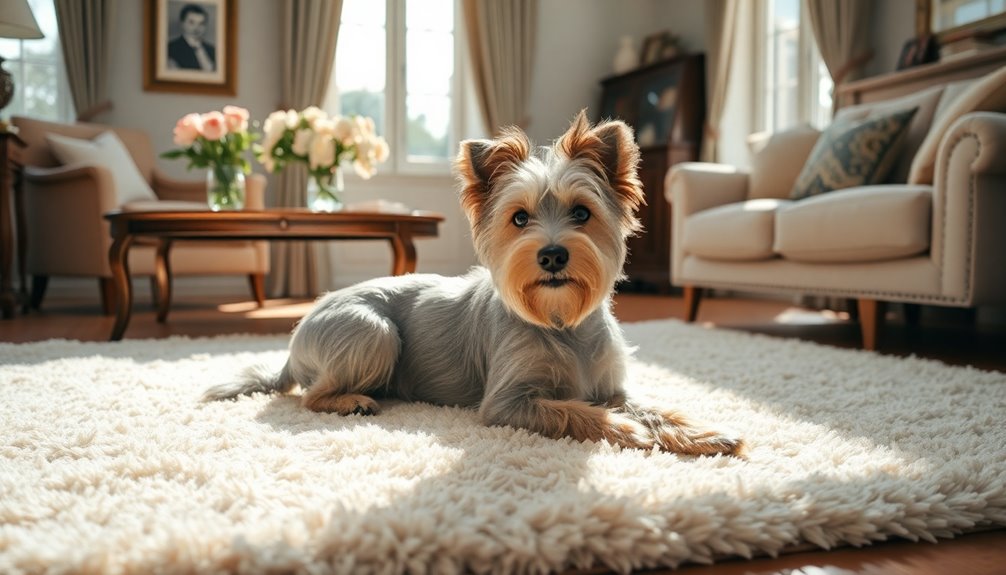
If you're considering a Dandie Dinmont Terrier, you'll find they do well in small homes with outdoor access.
They prefer moderate temperatures year-round, making them comfortable in various climates.
Just remember, daily walks are essential to keep them happy and healthy.
Small Home With Outdoor Access
A Dandie Dinmont Terrier thrives in a small home with outdoor access, making it an ideal companion for apartment dwellers or those with limited space. Standing just 8-11 inches tall and weighing between 18-24 pounds, this compact breed adapts well to smaller living environments.
While a large yard isn't necessary, having access to an outdoor area allows your Dandie to explore and play, which is vital for their happiness. Daily walks are essential, ideally 20-40 minutes, to keep your dog healthy and prevent weight gain. Additionally, their non-shedding coat makes them a suitable option for allergy sufferers, allowing you to enjoy their company without worry.
Short bursts of exercise fit perfectly into your busy schedule, helping maintain their energy levels without overwhelming you. Just be cautious—don't let them off-leash in unfenced areas due to their strong prey drive.
Dandies bond closely with their families and do well in households with older children. They're affectionate yet may be reserved with strangers. If you work long hours, consider getting another pet, as Dandies dislike being left alone for too long.
With the right balance of love, exercise, and attention, a Dandie Dinmont Terrier will thrive in your small home.
Prefers Moderate Temperatures Year-Round
Dandie Dinmont Terriers thrive in environments that maintain moderate temperatures year-round, which greatly contributes to their overall well-being.
You'll notice that these dogs begin to show signs of overheating when the temperature rises between 81 and 85 degrees Fahrenheit, so keeping your home below that threshold is essential. While they can adapt to various climates, they prefer consistent, moderate conditions for optimal comfort.
Since Dandie Dinmonts rely on panting to cool down, they need an environment that allows for effective temperature regulation. Their unique, non-shedding coat provides insulation against both heat and cold, but it also requires regular grooming to maintain its insulating properties. Panting serves as their primary means of cooling, making it crucial to monitor their breathing during warmer days.
This breed isn't high-strung; they enjoy moderate exercise—around 20 to 40 minutes daily—to help them maintain a comfortable body temperature.
Whether you're living in the country or an apartment, ensuring that your Dandie Dinmont Terrier has regular access to outdoor activities while keeping indoor temperatures stable is key.
Distinctive "Dandie" Name Origin
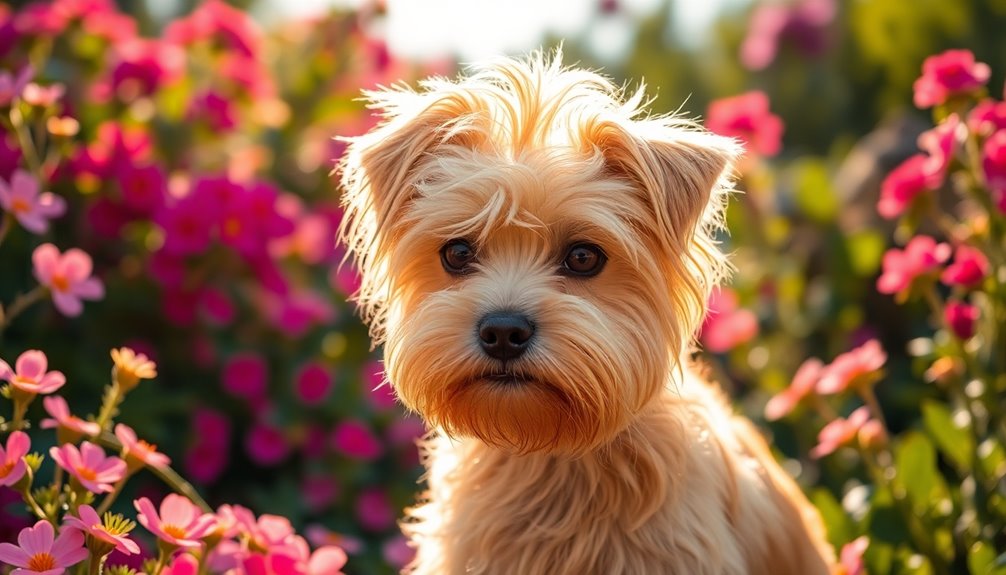
You've probably noticed the unique name "Dandie Dinmont" evokes a sense of character and history.
This name not only honors a fictional character from Sir Walter Scott's novel but also reflects the breed's distinctive tail characteristics that set them apart.
Plus, you'll find that this charming breed has made its mark in children's literature, adding to its rich legacy. In fact, the Dandie Dinmont Terrier has existed for over 300 years, showcasing a long-standing companionship with humans.
Distinctive "Dandie" Tail Characteristics
Typically, the Dandie Dinmont Terrier's tail is one of its most distinctive features, showcasing unique characteristics that set it apart from other breeds. Measuring between 20-25 cm (8-10 inches), the tail is thick at the root and maintains a natural curve resembling a scimitar, tapering to a point. You'll notice that it doesn't twist or curl, presenting a smooth line that flows from the loin.
When your Dandie gets excited, the tail points upward, forming a perpendicular line from root to tip. In a relaxed state, it's carried slightly above body level, never too high or low. The tail's gaily carried position reflects the dog's energy, maintaining that signature backward curve. The length and shape of the tail are important factors in exemplifying the breed's overall structure.
The fur on the tail adds to its charm: the upper side features wiry hair, often darker than the body, while the underside showcases softer feathering, about 5 cm (2 inches) long.
This color variation and texture difference emphasize the tail's role as a natural extension of the body, aiding balance and movement. The tail not only enhances your Dandie's appearance but also expresses its excitement and vitality.
Famous Dandie in Children's Literature
Inspired by the character from Sir Walter Scott's novel *Guy Mannering*, the Dandie Dinmont Terrier's name has become deeply rooted in children's literature. This charming breed got its name in 1814, after a character based on a real person, Mr. Davidson, a breeder of game dogs. Before this, the breed was known as Mustard and Pepper Terriers, a nod to their coat colors.
Scott's portrayal of Dandie Dinmont not only brought attention to these terriers but also helped solidify their identity. In the novel, Dandie Dinmont serves as a beloved figure, showcasing the terrier's endearing qualities. Additionally, the breed has gained recognition due to its safe and trusted content that appeals to families and children alike.
Scott's vivid descriptions captivated readers and made the Dandie Dinmont Terrier a favorite among families. The character's companionship with the terriers highlighted their appeal as gentle, loyal pets, leading to increased popularity.
The Dandie Dinmont's historical roots and literary significance make it a standout in canine history. Today, when you think of the Dandie Dinmont Terrier, you can't help but recall the charming stories that brought this unique breed into the hearts of children and adults alike.
The legacy of Dandie Dinmont continues to influence how we see this distinctive terrier today.
Small Home Compatibility?
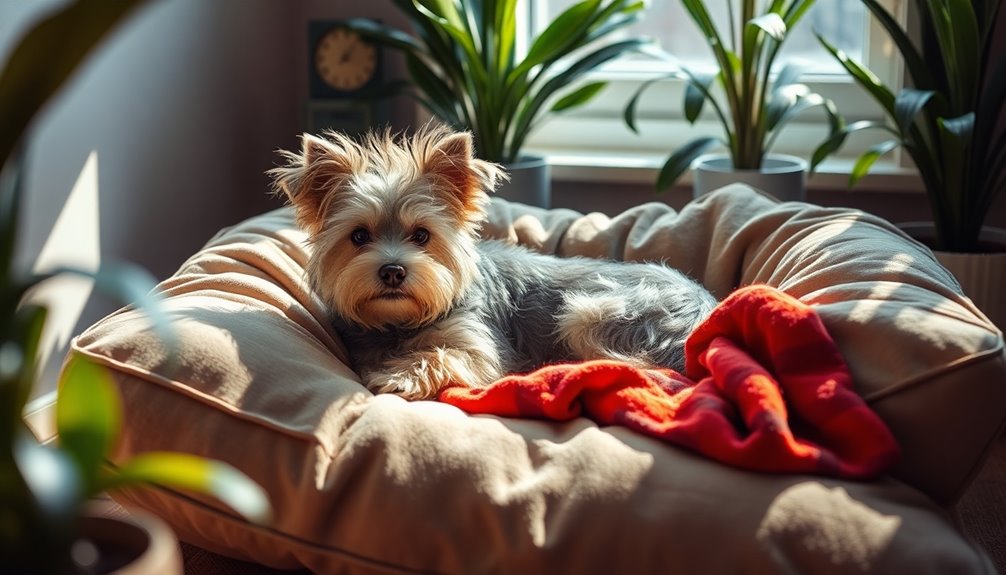
If you're considering a Dandie Dinmont Terrier for your small home, you'll find they're quite adaptable and ideal for active individuals. Their compact size makes them perfect for apartments, but keep in mind they do need regular grooming and mental stimulation. With some daily walks and playtime, you'll have a happy, well-adjusted companion by your side. Additionally, their affectionate temperament makes them great companions for families and individuals alike.
Ideal for Active Individuals
Embracing an active lifestyle, the Dandie Dinmont Terrier makes an excellent companion for individuals living in smaller homes. With a moderate energy level, this breed requires at least 30 minutes to an hour of exercise each day, which can include daily walks, playtime, and engaging in low-impact canine sports like agility or obedience. Their compact size, standing 8-11 inches tall and weighing 18-24 pounds, makes them perfectly suited for apartment living while still thriving in rural settings. These friendly and affectionate dogs bond well with all family members, including children, making them great companions for active households. They enjoy interactive play sessions and need regular physical and mental stimulation to stay happy and healthy. Their lifespan is typically between 12 to 15 years, ensuring many years of companionship. Though they don't demand excessive exercise, consistency in training is essential due to their independent nature. Dandie Dinmont Terriers adapt easily to various living conditions but benefit from opportunities to explore nature. Just ensure they've controlled play sessions as puppies to avoid overexertion, and you'll find this breed to be a loyal and engaging partner in your active lifestyle.
Grooming Needs and Maintenance
While Dandie Dinmont Terriers are well-suited for smaller homes, their grooming needs require your attention to keep their unique coats in shape. Daily brushing is essential to prevent matting and tangles, and you'll want to use a harsh brush for the best results. Their distinctive double coat features a soft undercoat and a harder topcoat, which needs to be hand-stripped periodically to maintain that classic look. Depending on your desired appearance, you may need to hand-strip every quarter, every other month, or more frequently. Don't forget to start hand-stripping puppy coats around four months old.
To groom your Dandie, equip yourself with a bristle brush, fine or coarse comb, and a soft wire slicker brush. You'll also need thinning shears and straight scissors for trimming. During brushing sessions, remember to check for any sores, scratches, or pests, as regular grooming promotes overall skin health. Additionally, their low-maintenance grooming routine makes them an excellent choice for busy owners. Daily grooming not only keeps their coat in check but also allows you to inspect their teeth, eyes, ears, and nails.
With the right tools and care, your Dandie will thrive in your small home environment.
Frequently Asked Questions
How Do Dandie Dinmont Terriers Interact With Children?
Dandie Dinmont Terriers can be great companions for children when properly socialized.
You'll find they're friendly, affectionate, and gentle, making them suitable playmates.
It's essential to supervise interactions, ensuring both the dog and child feel safe.
Teach kids how to approach and handle the dog gently, as rough handling can lead to negative reactions.
With the right guidance, these dogs can thrive in family settings and form strong bonds with older children.
What Is the Average Cost of a Dandie Dinmont Terrier?
The average cost of a Dandie Dinmont Terrier ranges from $1,500 to $3,000 when purchasing from a breeder. This price can vary based on pedigree and availability, and you might've to travel or join a waiting list due to their rarity.
On the other hand, adoption costs are significantly lower, typically between $100 and $500, and often include essential veterinary services, making it a more budget-friendly option.
Do Dandie Dinmont Terriers Shed a Lot?
No, Dandie Dinmont Terriers don't shed a lot.
They're classified as a non-shedding breed, thanks to their unique double coat that features a wiry topcoat and a soft undercoat.
While you won't find much hair around your home, regular grooming is essential to keep their coat healthy and mat-free.
Brushing several times a week will help maintain their coat and prevent any buildup of loose hair, ensuring a happy, tidy pup.
What Are Common Behavioral Issues in Dandie Dinmont Terriers?
Common behavioral issues in Dandie Dinmont Terriers include stubbornness, separation anxiety, and a strong prey drive.
You might notice them being territorial, especially with larger dogs. They can develop excessive barking habits if not trained early, and their independent nature can lead to defiance.
To manage these behaviors, be consistent with training, use positive reinforcement, and ensure they're socialized early.
Patience and a structured routine will help keep them well-behaved.
Can Dandie Dinmont Terriers Live in Apartments?
Yes, you can absolutely have a Dandie Dinmont Terrier in an apartment. Their compact size makes them well-suited for smaller spaces.
Just ensure you provide daily walks and playtime to meet their moderate exercise needs. They thrive on mental stimulation, so interactive toys and games are essential to keep boredom at bay.
With proper care and attention, they'll adapt beautifully to your apartment lifestyle, becoming a loving companion in your home.
Conclusion
In conclusion, the Dandie Dinmont Terrier stands out with its unique style and charming personality. Whether you're drawn to its rich history or its playful nature, this breed can be a wonderful companion. With proper training and a loving environment, you'll find that a Dandie can thrive in smaller homes just as easily as larger ones. If you're ready to embrace their quirks and loyalty, you'll surely enjoy a fulfilling life together with your Dandie Dinmont.

